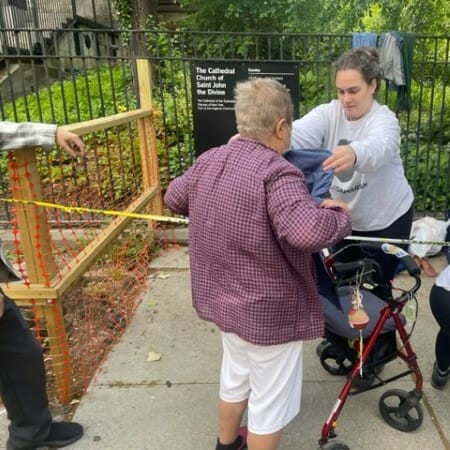New York Social Worker Hits the Streets to Help the Unhoused


Meet Daily Point of Light Award honoree Emily Borghard. Read her story and nominate an outstanding volunteer or family as a Daily Point of Light.
Emily Borghard, 34, grew up on a dairy sheep farm in upstate New York after her family returned from a few years in France. Her mom was inspired to make cheese. Emily came back bilingual and later added Spanish to her repertoire. After college, she dove into teaching English as a second language back in France. While there, she discovered humanity in the way the French treated those living on the street and wanted to do more.
Emily found her passion in social work and now works at Columbia Neurology, the same department that saved her life with a groundbreaking experimental surgery for epilepsy in high school. By day, she helps people struggling in a formal setting, but for the past four years, on nights and weekends, she has worked with her nonprofit, Sidewalk Samaritan, connecting New York’s unhoused with resources.
Her wide-ranging role encompasses everything from managing Sidewalk Samaritan’s online presence to educating the public, organizing fundraisers and handout days, to lining up companies willing to donate. Along with her work, she also cares for two of her mom’s outgoing former barn cats who get jealous when they can’t make an appearance on each of her Zoom calls.
What inspires you to volunteer?
I love the book and, later, the movie, Pay It Forward. The idea is that one person helps three people and then each of those people helps three other people. Nobody owes anything. It only goes forward.
I also realized how much more respectful people are to the unhoused in France versus New York City. In France, people were sitting down street-side talking to and acknowledging the person in front of them. Once, in New York, I was walking by someone holding up a sign when they were panhandling that said, I might as well be invisible. That’s how people treat people experiencing homelessness here.
I met a sweet gentleman named Mark sleeping in the subway. I started talking with him and asking if there were things he needed. He never wanted anything for himself, but he always knew somebody who needed something. Mark was a big part of the inspiration for what started out as me handing out socks and became Sidewalk Samaritan. He passed away a few years ago, but I wish he could see where we are now. His mom contacted me to thank me, because she knew that I was in touch with him during the last few years of his life.

Describe your role with Sidewalk Samaritan.
I work on promotions and inventory. I also do media pieces, and I’m out there on the street. I always have a ginormous backpack on, and it’s not stuff that I need for work. It’s filled with socks, toiletries, underwear, T-shirts, etc. for when I come across anybody who needs it.
On Sunday of Memorial Day weekend, I covered 44 blocks. On Monday, 38. There are certain locations that I’ve kept track of that tend to have more people. For example, during the wintertime, I know which subways are heated or have bathrooms. I have a detailed list of locations – -or both warm and cold weather – where I can ensure they get supplies and meals.
My mom is also a huge player. She just received 20 boxes from the apparel company Bombas. You can’t have big shipments delivered in New York City. Things would get stolen. She drives three hours each way every couple of weeks to help with the big handouts.
What’s been the most rewarding part of your work?
When we do our shoe day, which is a big handout, people get to choose what color shoes they want, and it means so much to them. We’ve had people cry because they haven’t had shoes or a new pair in so long. It’s something so basic.
What is your biggest challenge?
People being receptive has been one of the biggest challenges. One of our big handout locations is in front of a church. Locals were upset. I had somebody smack me on the back of the head the other day and tell me that I am doing the devil’s work. It took a while for the church itself to be receptive to us, too, because it’s also a big tourist location and we had a line of people who are unhoused out front.
Also, everything I knew about the best subway stations in which to hand things out was different through COVID. The police were coming through and making sure that nobody was sticking around. The bathrooms in all the public spaces — like parks — were closed. The news featured a piece about increased urination in the streets and human feces.
People blamed the unhoused. These guys were trying to find places that would let them use bathrooms, and nobody was letting them in, because everyone was terrified of COVID. They couldn’t even go into a fast-food restaurant. We spent most of the first summer of the pandemic racing around getting masks out to everybody so they could hopefully go inside somewhere.
For the unhoused population the pandemic happened overnight. They weren’t watching TV and reading the news. They were used to sleeping in the subway stations and all of a sudden, they weren’t allowed.
What have you learned through your experiences as a volunteer?
It’s not just about educating people but trying to bring back inspiration where a lot of it was lost. People will stop to ask what we do, and I’ll give them a business card. A lot of those people end up making financial donations.
People have lost faith in humanity to some extent. It’s out there. They just have to be seeing it.
Are there any future partnerships, programs, or events that you are excited about?
I’m working on is being able to have emergency packs that we can supply hospitals with. They’ll have things like socks, underwear, toiletries, sweatshirts, sweatpants and a pair of Crocs. I keep running into people on the streets in scrubs. With one man, I had to intervene, because the police were about to arrest him for indecent exposure. His scrubs were around his ankles, because they were too big.
All of these people still had hospital wristbands on. Because of COVID, when the unhoused come into the hospitals, they cut off all their clothes and throw them away. Then they discharge them, but they don’t have any clothes, so they just shove them off with a pair of extra-large scrubs. They had little before, but now they have nothing. The goal is for hospitals to give these packs out to the unhoused after they’re treated.
Why is it important for others to get involved in causes they care about?
It’s the idea of paying it forward. There will be a time in everyone’s life when you’re going to need help. When that time comes, can’t pay back what was given to you. But instead, you can help others.
What do you want people to learn from your story?
Just acknowledge someone on the street. You don’t know what’s going on in their head or what their day has been like. For all you know, you may have just stopped them from doing something negative for themselves. You can be that change.
I hope my story can be inspiring. And I hope it teaches people that it doesn’t take a millionaire-effort to make a change. All it takes is a pair of socks.
Do you want to make a difference in your community like Emily? Find local volunteer opportunities.